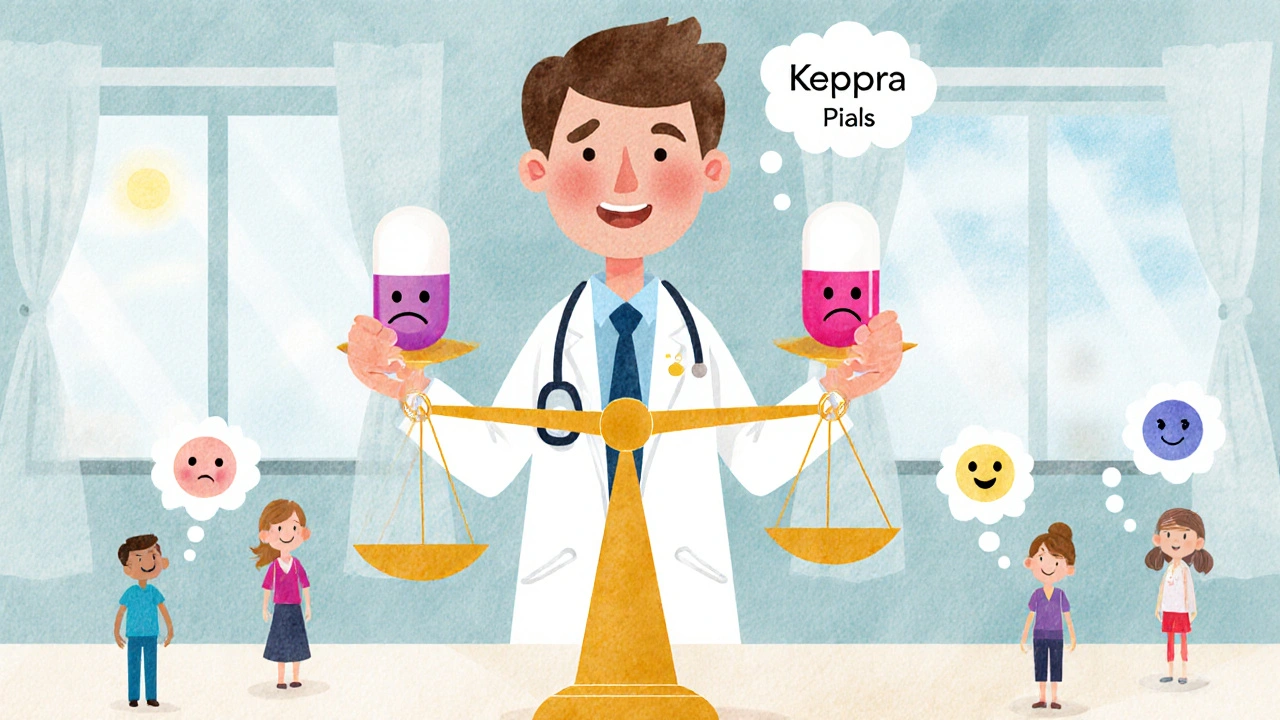Seizure Medication Comparison Tool
Compare Keppra and other seizure medications based on your top priorities. Select what matters most to you and see which options best match your needs.
What matters most to you?
Your Options
Keppra (Levetiracetam)
If you or someone you care about is taking Keppra (levetiracetam) for seizures, you’ve probably wondered: are there better options? Maybe the side effects are getting tough, or the cost is climbing, or it just isn’t working as well as it used to. You’re not alone. Thousands of people with epilepsy or seizure disorders regularly ask the same question. The truth is, Keppra isn’t the only game in town-and it might not even be the best fit for everyone.
What Keppra Actually Does
Keppra, the brand name for levetiracetam, is an antiepileptic drug (AED) used to treat partial-onset seizures, myoclonic seizures, and primary generalized tonic-clonic seizures. It works differently than older meds like phenytoin or carbamazepine. Instead of calming down electrical overactivity in the brain by blocking sodium channels, Keppra binds to a protein called SV2A, which helps regulate how brain cells release neurotransmitters. This unique mechanism means it’s less likely to interfere with other medications, which is why doctors often prescribe it alongside other drugs.
It’s available as tablets, oral solution, and IV infusion. Most adults start at 500 mg twice daily and increase by 500 mg every two weeks until seizures are controlled or side effects appear. The average effective dose is 1,000-3,000 mg per day. It’s not a cure, but for many, it cuts seizure frequency by half or more.
Common Side Effects of Keppra
Keppra is generally well-tolerated, but side effects happen. About 1 in 3 people report them. The most common:
- Drowsiness or fatigue (up to 30% of users)
- Dizziness (15-20%)
- Headache (10-15%)
- Loss of appetite or weight loss
- Mood changes: irritability, aggression, depression (5-10%, sometimes serious)
- Weakness or coordination issues
Some people report sudden personality shifts-anger outbursts, anxiety, or even suicidal thoughts. The FDA issued a warning about this in 2009. If you or a loved one starts acting out of character, talk to your doctor immediately. These side effects are less common in kids but still possible.
Top Alternatives to Keppra
There are over 20 FDA-approved seizure medications. Here are the most commonly prescribed alternatives to Keppra, with real-world pros and cons.
1. Lamotrigine (Lamictal)
Lamotrigine is one of the most popular alternatives. It’s effective for partial and generalized seizures, including absence seizures. It’s often used in women of childbearing age because it has a lower risk of birth defects compared to valproate.
Pros: Low weight gain, minimal drug interactions, good for long-term use, less likely to cause drowsiness than Keppra.
Cons: Slow dose escalation (takes weeks to reach therapeutic levels), risk of serious skin rash (Stevens-Johnson syndrome) if increased too fast, especially if taken with valproate. Requires strict titration.
Many patients switch from Keppra to Lamictal when mood side effects become overwhelming.
2. Lacosamide (Vimpat)
Lacosamide works by enhancing slow inactivation of sodium channels, which helps stabilize overactive nerve cells. It’s often added to other meds when seizures aren’t fully controlled.
Pros: Fast-acting, works well as an add-on therapy, low risk of cognitive side effects like brain fog.
Cons: Can cause dizziness, double vision, and heart rhythm changes (QT prolongation). Not ideal for people with heart conditions. Also more expensive than Keppra in many regions.
Used mostly as a second-line option, especially when Keppra’s mood side effects are too disruptive.
3. Oxcarbazepine (Trileptal, Oxtellar)
This is a cousin of carbamazepine but with fewer side effects. It’s great for partial seizures and often used in children.
Pros: Fewer drug interactions than carbamazepine, less risk of blood cell issues, generally better tolerated than older meds.
Cons: Can cause low sodium levels (hyponatremia), especially in older adults. Dizziness and fatigue are common. Less effective for generalized seizures than Keppra.
Good choice if you need something cheaper than Keppra and don’t have generalized epilepsy.
4. Zonisamide (Zonegran)
Zonisamide is a multi-action drug that blocks sodium and calcium channels and enhances GABA activity. It’s used for partial seizures and sometimes for Lennox-Gastaut syndrome.
Pros: Can help with weight loss (useful for people gaining weight on other meds), once-daily dosing, long half-life.
Cons: Risk of kidney stones, cognitive slowing, reduced sweating (risk of overheating), and rare cases of acute angle-closure glaucoma.
Not first-line, but a solid option if Keppra causes weight gain or you need fewer daily doses.
5. Valproate (Depakote)
Valproate is one of the broadest-spectrum AEDs. It works for almost all seizure types, including absence, myoclonic, and tonic-clonic.
Pros: Highly effective, especially for generalized epilepsy syndromes, low cost.
Cons: High risk of liver damage, pancreatitis, weight gain, hair loss, and polycystic ovary syndrome (PCOS) in women. Teratogenic-can cause severe birth defects. Avoided in women of childbearing age unless no other option.
Still used, but only when newer drugs fail. Keppra replaced it for many because of safety.
6. Topiramate (Topamax)
Topiramate is used for partial seizures and primary generalized tonic-clonic seizures. It’s also used for migraine prevention.
Pros: Can help with weight loss, effective for refractory seizures, works well in combination therapy.
Cons: High risk of cognitive side effects: memory issues, trouble finding words, brain fog. Kidney stones, metabolic acidosis, and vision changes (like glaucoma) are possible. Often causes tingling in hands and feet.
Many patients stop Topiramate because the mental fog is too disabling-even if seizures improve.
Comparison Table: Keppra vs. Top Alternatives
| Medication | Seizure Types Treated | Common Side Effects | Mood Effects | Dosing Frequency | Cost (Approx. monthly, US) |
|---|---|---|---|---|---|
| Keppra (levetiracetam) | Partial, myoclonic, tonic-clonic | Drowsiness, dizziness, irritability, fatigue | High risk of aggression, depression | Twice daily | $150-$300 |
| Lamotrigine (Lamictal) | Partial, absence, tonic-clonic | Dizziness, headache, rash (serious if rushed) | Low risk; may improve mood | Once or twice daily | $100-$250 |
| Lacosamide (Vimpat) | Partial (add-on) | Dizziness, double vision, nausea | Low risk | Twice daily | $400-$600 |
| Oxcarbazepine (Trileptal) | Partial | Dizziness, fatigue, low sodium | Low risk | Twice daily | $80-$200 |
| Zonisamide (Zonegran) | Partial, some generalized | Kidney stones, weight loss, reduced sweating | Mild cognitive slowing | Once or twice daily | $150-$350 |
| Valproate (Depakote) | Most types, especially generalized | Weight gain, tremor, liver risk | Can cause depression | Twice daily | $30-$100 |
| Topiramate (Topamax) | Partial, tonic-clonic | Brain fog, tingling, kidney stones | High risk of cognitive slowing | Once or twice daily | $120-$280 |

When to Consider Switching from Keppra
Switching meds isn’t something you do on a whim. But here are clear signs it might be time:
- Your seizures aren’t improving after 3 months on a stable dose
- You’re experiencing mood swings, depression, or aggression that affects work or relationships
- You’re gaining weight and can’t lose it despite diet and exercise
- You’re on multiple meds and Keppra is causing too many interactions
- The cost is unaffordable and you don’t have good insurance coverage
Don’t stop Keppra suddenly. Abrupt withdrawal can trigger status epilepticus-a life-threatening seizure emergency. Always taper under medical supervision.
What About Newer Options? (2025 Updates)
In 2024, the FDA approved cenobamate (Xcopri) for partial-onset seizures. Early data shows it reduces seizures by over 50% in 60% of patients who’ve tried at least two other drugs. It’s potent but carries a risk of dizziness and sedation. It’s also very expensive-over $800/month in the U.S.-and not widely covered yet.
Another emerging option is cannabidiol (Epidiolex), approved for rare epilepsy syndromes like Dravet and Lennox-Gastaut. It’s not for general epilepsy, but if you have one of these rare forms, it’s a game-changer. Side effects include sleepiness, diarrhea, and liver enzyme changes.
For most people, though, the alternatives listed above are still the standard. Newer drugs are reserved for when older ones fail.
Real Patient Experiences
One 32-year-old teacher in Melbourne switched from Keppra to Lamictal after experiencing violent outbursts at work. Within two months, her mood stabilized and her seizures dropped from 4 a week to 1 every 2 weeks. She says, “I didn’t realize how much Keppra was making me angry until it was gone.”
A 68-year-old man with kidney issues tried zonisamide after Keppra caused frequent dizziness. He lost 8 kg, his seizures improved, and his doctor was happy he wasn’t gaining weight. “It’s not perfect,” he says, “but I can walk to the shops again.”
Not everyone’s story ends well. One woman tried topiramate after Keppra failed. She developed severe brain fog and couldn’t remember her own phone number for weeks. She went back to Keppra, even though it made her tired. “Better tired than lost,” she said.

How to Talk to Your Doctor About Switching
Don’t go in saying, “I want to quit Keppra.” Go in with questions:
- “Are my seizures still controlled, or is this medication losing its effect?”
- “Could my mood changes be linked to Keppra?”
- “What are the risks and benefits of switching to Lamictal or oxcarbazepine?”
- “Will my insurance cover the alternative?”
- “How long will the transition take? Will I need blood tests?”
Bring a list of your symptoms, seizure logs, and any side effects you’ve noticed. The more specific you are, the better your doctor can help.
Final Thoughts
Keppra is a good drug for many people. It’s effective, widely used, and has fewer interactions than older meds. But it’s not perfect. If you’re struggling with side effects-or it’s just not working anymore-you have options. Lamotrigine is often the best next step for mood-related issues. Oxcarbazepine is cheaper and gentler for partial seizures. Zonisamide helps if weight gain is a problem.
The key is not to suffer in silence. Seizure control and quality of life go hand in hand. If one drug isn’t working, it doesn’t mean you’re out of options. It just means it’s time to try another.
Is Keppra better than Lamictal for epilepsy?
It depends. Keppra works faster and is effective for more seizure types, including myoclonic seizures. Lamictal is often better for mood and has fewer cognitive side effects. If you have depression or anxiety, Lamictal is usually preferred. If you need quick seizure control and don’t have mood issues, Keppra might be better.
Can you switch from Keppra to another drug safely?
Yes, but never stop Keppra suddenly. Your doctor will slowly reduce your dose while gradually increasing the new medication. This process usually takes 4-8 weeks. Stopping abruptly can cause rebound seizures or even status epilepticus, which is life-threatening.
What’s the cheapest alternative to Keppra?
Oxcarbazepine and valproate are typically the most affordable. Generic oxcarbazepine can cost as little as $30 a month in the U.S. Valproate is even cheaper, but it comes with serious safety risks, especially for women. Always weigh cost against safety.
Does Keppra cause weight gain?
Unlike many seizure meds, Keppra is more likely to cause weight loss or no change. About 10-15% of users report decreased appetite. If you’re gaining weight on Keppra, it’s likely due to other factors like diet, inactivity, or another medication you’re taking.
Are there natural alternatives to Keppra?
No proven natural alternatives exist that can replace Keppra for controlling seizures. Some people use CBD (Epidiolex) for specific rare syndromes, but it’s not a supplement-it’s a prescription drug. Vitamins, ketogenic diets, or herbal remedies may help as add-ons, but they should never replace prescribed medication without medical supervision.
Next Steps
If you’re thinking about switching:
- Track your seizures and side effects for at least 2 weeks. Use a journal or app.
- Make a list of your top concerns: mood, weight, cost, drowsiness?
- Ask your neurologist: “What’s the next best option for me?”
- Check your insurance formulary-some alternatives are much cheaper.
- Don’t rush. Give any new medication at least 6-8 weeks to stabilize.
Seizure control isn’t just about stopping convulsions. It’s about living without fear, without brain fog, without anger. You deserve a treatment that works-not just one that’s been around the longest.



Comments (14)
Michael Petesch
Interesting breakdown. I've been on Lamictal for 7 years now-seizure-free, no brain fog, and my mood is stable. The slow titration was brutal, but worth it. Keppra made me feel like a zombie with occasional rage episodes. Switching was the best decision I ever made.
Reema Al-Zaheri
While the data presented is statistically sound, it lacks critical context regarding long-term neurocognitive outcomes. Many patients experience cumulative deficits with polypharmacy, particularly with sodium-channel blockers. The absence of EEG correlation data diminishes clinical utility.
Michael Salmon
Let’s be real-Keppra is the pharmaceutical industry’s answer to ‘We need something that looks new but isn’t.’ It’s overprescribed because it’s profitable, not because it’s superior. Doctors push it because it’s easy to write and insurance covers it. Patients pay the price in mood crashes and cognitive decline.
Joe Durham
I get why people hate Keppra’s mood side effects. My sister went from calm to screaming at the TV over spilled coffee. We switched to Lamictal-same seizure control, zero rage. It’s not perfect, but it’s human. If you’re struggling, don’t feel guilty for wanting better. Your brain deserves more than a chemical band-aid.
Timothy Reed
For anyone considering a switch: document everything. Seizure frequency, mood logs, sleep patterns, even food intake. Bring it to your neurologist. They’re not mind readers. The more data you give them, the better the decision. And yes-ask about cost. Many clinics have patient assistance programs you didn’t know existed.
harenee hanapi
Ugh, I tried Zonisamide. Lost 15 pounds in two months. My hair fell out. I couldn’t sweat. I got heatstroke walking to my mailbox. Now I’m back on Keppra and I’m just tired. At least I don’t die in the sun. This whole thing is a nightmare. Why can’t they just make one drug that doesn’t turn you into a different person?
Christopher Robinson
Big shoutout to anyone reading this who’s on a seizure med and feels alone. You’re not. I’ve been on 5 different drugs over 12 years. Some worked, some didn’t. The one thing that helped more than any pill? Finding a support group. Reddit, Facebook, local meetups-it changes everything. 💪
James Ó Nuanáin
As a British neurologist with 27 years’ experience, I must emphasize that the American tendency to over-medicate epilepsy is both irresponsible and culturally perverse. In the NHS, we reserve Keppra for refractory cases and prioritize lamotrigine as first-line. The cost comparisons here are misleading-when you factor in hospitalizations from mood-induced crises, Keppra is the most expensive option.
Nick Lesieur
So Keppra makes you angry. Wow. Groundbreaking. Next you’ll tell me water is wet. I’ve been on it for 3 years. I’m fine. Everyone else just can’t handle their emotions. Maybe stop blaming the drug and start therapy? 😴
Angela Gutschwager
I switched to oxcarbazepine. Cost $40/month. No mood swings. No brain fog. Just a little dizzy sometimes. Keppra was $280. I’m not rich. This isn’t a luxury. It’s survival.
Andy Feltus
Isn’t it ironic? We treat epilepsy like a machine that needs tuning, but the brain isn’t a carburetor. We swap drugs like spare parts, ignoring the person inside. Maybe the real question isn’t ‘Which drug is better?’ but ‘Why are we so quick to chemically remodel someone’s soul to fit a treatment protocol?’
Kara Binning
My daughter was on Keppra. She went from A+ student to crying in the bathroom every day. We tried Lamictal. Nothing. Then Topamax. She forgot how to spell her own name. We’re back on Keppra. I’m not happy. But I’m not risking her safety. Sometimes, you don’t get the perfect answer. You get the one that keeps them breathing.
seamus moginie
Keppra is a weaponized placebo wrapped in a patent. I’ve seen more patients ruined by it than helped. The FDA warning? A footnote. Doctors don’t warn you because they don’t want to admit they’re prescribing a mood grenade. If you’re on it and you’re not yourself-get off. Slowly. But get off.
Derron Vanderpoel
Just wanted to say thank you for this post. I’ve been too scared to talk to my doctor about switching. But now I know I’m not crazy for feeling like a different person. I’m printing this out and taking it with me. I’m not giving up. 💙